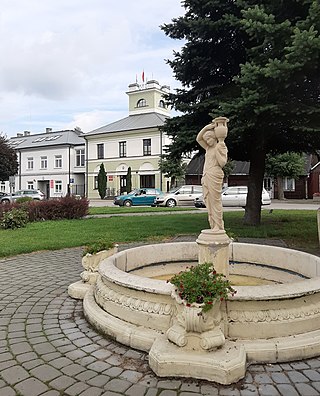
The Ninth Fort is a stronghold in the northern part of Šilainiai elderate, Kaunas, Lithuania. It is a part of the Kaunas Fortress, built in the late 19th century. During the Soviet occupation, the fort was used as a prison and way-station for prisoners being transported to labour camps. After the occupation of Lithuania by Nazi Germany, the fort was used as a place of execution for Jews, captured Soviets, and others.

Pruszków is a city in east-central Poland, capital of Pruszków County in the Masovian Voivodeship. Pruszków is located along the western edge of the Warsaw metropolitan area.

Pierre Eugène Drieu La Rochelle was a French writer of novels, short stories, and political essays. He was born, lived and died in Paris. Drieu La Rochelle became a proponent of French fascism in the 1930s, and was a well-known collaborationist during the German occupation. He is best known for his books Le Feu Follet and Gilles.

Jaan Kross was an Estonian writer. He won the 1995 International Nonino Prize in Italy.

Anna Seghers, is the pseudonym of German writer Anna Reiling, who was notable for exploring and depicting the moral experience of the Second World War. Born into a Jewish family and married to a Hungarian Communist, Seghers escaped Nazi-controlled territory through wartime France. She was granted a visa and gained ship's passage to Mexico, where she lived in Mexico City (1941–47).

Łapanka was the Polish name for a World War II practice in German-occupied Poland, whereby the German SS, Wehrmacht and Gestapo rounded up civilians on the streets of Polish cities. The civilians arrested were in most cases chosen at random from among passers-by or inhabitants of city quarters surrounded by German forces prior to the action.
Wartime collaboration is cooperation with the enemy against one's country of citizenship in wartime. As historian Gerhard Hirschfeld says, it "is as old as war and the occupation of foreign territory".

Hebburn is a town in the South Tyneside borough of Tyne and Wear, England. It was formerly in County Durham until 1974 with its own urban district from 1894 until 1974. It is on the south bank of the River Tyne between Gateshead and Jarrow and opposite Wallsend and Walker.

Sosnove is a rural settlement in Rivne Raion of Rivne Oblast, Ukraine, located in the historic region of Volhynia. Population: 1,925.

During World War II, Lithuania was occupied twice by the Soviet Union and once by Nazi Germany (1941–1944). Resistance took many forms.
Hans Kirk was a Danish lawyer, journalist and celebrated author, who penned the best-selling novel of all-time in his native Denmark, The Fishermen (1928). From 1926 to 1928 he was among the contributors of Kritisk Revy, an architecture magazine. Kirk was a long-time Communist Party member in Denmark and remained active until his death. In 1941, during the German occupation, Kirk and hundreds of others were arrested without charge by the Danish police in a sweep against communists and communist sympathizers. He was imprisoned and detained at the Danish prison camp of Horserød, but managed to escape in 1943, just in time to avoid deportation to the German death camps.

Konstantinos Logothetopoulos was a distinguished Greek medical doctor who became Prime Minister of Greece, directing the Greek collaborationist government during the Axis occupation of Greece during World War II.
Arūnas Bubnys is a Lithuanian historian and archivist. He started his studies at Vilnius University in 1985. In 1993 he received a Ph.D. for the thesis Lietuvių antinacinė rezistencija 1941–1944 m..

Mogielnica is a town in Grójec County in Masovian Voivodeship, Poland, with 2,475 inhabitants (2004) and an area of 141.56 square kilometres. It is the seat of Gmina Mogielnica.
Lucjan Dobroszycki was a Polish scientist and historian specializing in modern Polish and Polish-Jewish history. A survivor of the Łódź Ghetto and Nazi concentration camps including Auschwitz, Dobroszycki lived in Poland after World War II where he obtained his education and worked as a historian. His main focus was the Nazi German occupation of Poland.

Le Vernet Internment Camp, or Camp Vernet, was a concentration camp in Le Vernet, Ariège, near Pamiers, in the French Pyrenees. It was built in 1918 as a barracks, but after World War I it was used as an internment camp for prisoners of war. From February 1939 to June 1944, it was used:

A hypothetical military victory of the Axis powers over the Allies of World War II (1939–1945) is a common topic in speculative literature. Works of alternative history (fiction) and of counterfactual history (non-fiction) include stories, novels, performances, and mixed media that often explore speculative public and private life in lands conquered by the coalition, whose principal powers were Nazi Germany, Imperial Japan, and Fascist Italy.

Fort de Romainville, was built in France in the 1830s and was used as a Nazi concentration camp in World War II.
There is a significant body of fiction set in an alternate history or a secret history, where the Operation Sea Lion, a German plan to invade Britain during World War II, is attempted or successfully carried out. However, analyses by experts during a wargame conducted in 1974 concluded that there was little chance of the plan succeeding.

This is a bibliographyof works on World War II.















